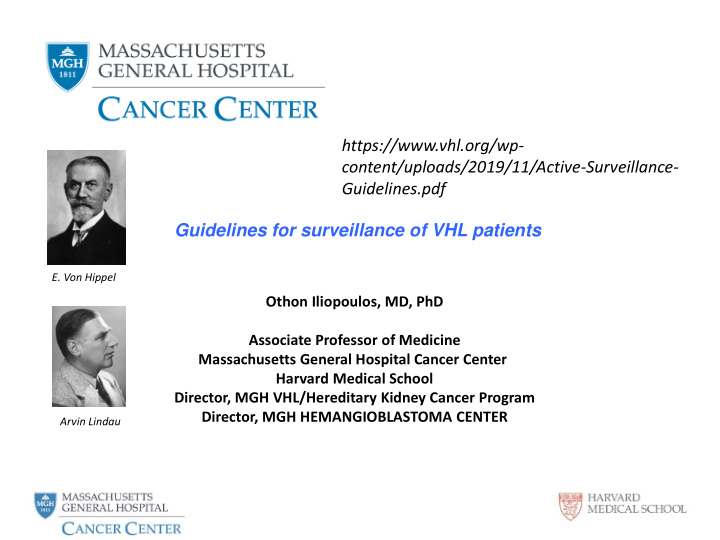



https://www.vhl.org/wp- content/uploads/2019/11/Active-Surveillance- Guidelines.pdf Guidelines for surveillance of VHL patients E. Von Hippel Othon Iliopoulos, MD, PhD Associate Professor of Medicine Massachusetts General Hospital Cancer Center Harvard Medical School Director, MGH VHL/Hereditary Kidney Cancer Program Director, MGH HEMANGIOBLASTOMA CENTER Arvin Lindau
Why should we do surveillance Prevent mortality AND morbidity from the disease Identify and treat Renal Cell Cancers (RCC) less than 3 cm Differentiate between adrenal adenomas and pheochromocytomas Diagnose and treat occult Paragangliomas (PGs) Diagnose and treat early pancreatic neuroendocrine tumors (pNET) and prevent their metastasis Diagnose, follow and time the intervention for CNS Hemangioblstomas (HB) Diagnose extra lymphatic sac tumors (ELST)
What determines when to start (initiation) and how often to perform surveillance (frequency) INITIATION is based on the earliest age of onset of the VHL-associated lesion FREQUENCY determined on the growth rate location metastatic potential ? mutation
How early can VHL lesions be detected
How early can VHL lesions be detected
Newborns, Infants and Children At Birth: Pediatrician to look for signs of neurological disturbance (nystagmus, strabismus, white pupil, other) Routine newborn hearing surveillance. N. Ehler & O. A. Jensen Juxtapapillary Retinal Hemangioblastoma (Angiomatosis Retinae) in an Infant: Light Microscopical and Ultrastructural Examination Ultrastructural Pathology. 1982, 3(4):pp 325-333 Age 1-4: Annual physical exam (blood pressure, vision, or hearing symptoms). Annual retinal examination by an ophthalmologist skilled in diagnosis and management of retinal disease Annual neurological exam (nystagmus, strabismus, white pupil, vision)
Ages 5-10: Annually Annual physical exam including detailed neurological exam (includes hearing exam) Annual retinal examination (eye dilation) Annual test for pheochromocytoma Blood or 24 hour urine catecholamines Epinephrine, nor-epinephrine, fractionated metanephrines and nor- metanephrines Abdominal MRI or MIBG scan only if biochemical abnormalities found Abdominal ultrasonography annually from 8 years or earlier if indicated
Ages 5-10 (continued) Every 2-3 Years Audiology assessment by an audiologist Annually if any hearing loss, tinnitus, or vertigo is found In the case of repeated ear infections, MRI with contrast of the internal auditory canal using thin slices, to check for a possible ELST.
Ages 10-14: Annual physical exam (including detailed neurological exam and hearing) Annual retinal examination Annual test for pheochromocytoma MRI of the brain and spine every 1-2 years
Ages 14 or 15+: Annual physical exam (including detailed neurological exam and hearing) Annual retinal examination Annual test for pheochromocytoma MRI of the brain and spine every 1-2 years MRI of the abdomen (kidneys, adrenals, pancreas) every 1-2 years
RCC less than 3 cm The 3 cm rule applies to “Solid RCC” What is the permissive size of a CYST?
Safety of Gadolinium based MRI contrast agents Nephrogenic Systemic Fibrosis GFR < 30cc/min Tissue deposition ? NOT with macrocyclic gadolinium J. Ramalho, R.C. Semelka, M. Ramalho, R.H. Nunes, M. AlObaidy and M. Castillo Gadolinium-Based Contrast Agent Accumulation and Toxicity: An Update American Journal of Neuroradiology 2016, 37 (7): 1192-1198
Do all VHL patients need surveillance for pheo/PG ? GENOTYPE - PHENOTYPE CORRELATIONS Germ-line mutations Phenotype Classification 46% Deletions 10% Nonsense H + RCC Type I 44% Missense N78H/S/T L184P/R S111R S80R/I Type II 96% Missense IIA PHEO+ H + RCC (low) Y98H Y112H IIB V74G R161G R167W/Q/G L178P/Q/V PHEO+ H + RCC (high) IIC S68W PHEO only L188V G114S F119S V84L V166F Penetrance is almost 100% Expressivity widely variable
VHL and pregnancy - 1 Small cohort of patients comparing pregnant VHL pt to match age controls Prospective studies of pregnant VHL women without comparison group Conflicting data Evidence indicates there is NO acceleration of tumor growth
VHL and pregnancy - 2 MRI with NO contrast poses no problem to fetus or mother at any trimester Gadlinium use in the FIRST trimester may increase risks to newborn (skin lesions, inflammatory or rheumatic conditions) Kanal E, Barkovich AJ, Bell C, Borgstede JP, Bradley WG Jr, Froelich JW, et al. ACR guidance document on MR safe practices: 2013. Expert Panel on MR Safety . J Magn Reson Imaging 2013;37:501–30 . Less than 0.04% gadolinium is excreted in milk only within the 24 hurs Theoretically breastfeeding should not be interrupted Out of abundance of caution we could suggest milk banking before MRI and resume lactation 48 hours after MRI Committee Opinion No. 723: Guidelines for Diagnostic Imaging During Pregnancy and Lactation. Obstet Gynecol. 2017;130:e210-e216 . [PubMed: 28937575]
Thank you………….. ………Time for questions
Recommend
More recommend